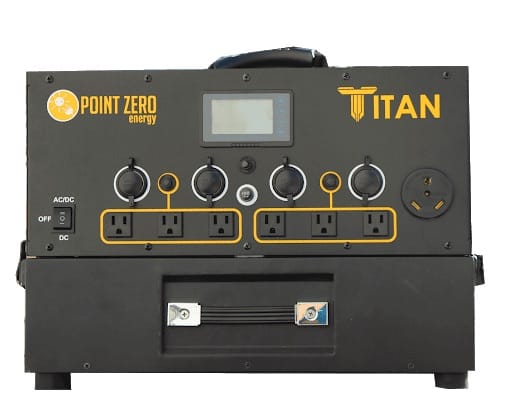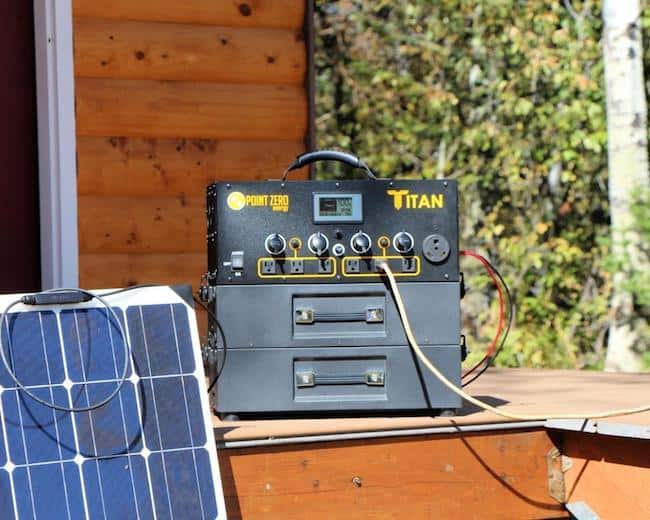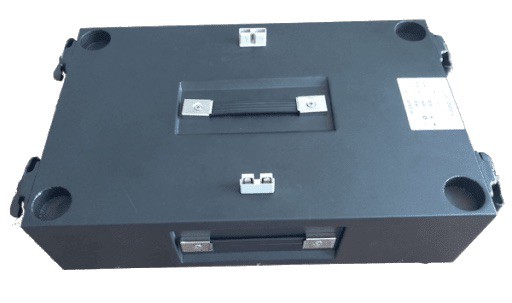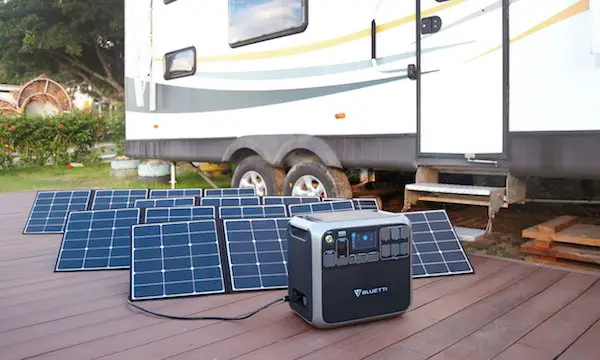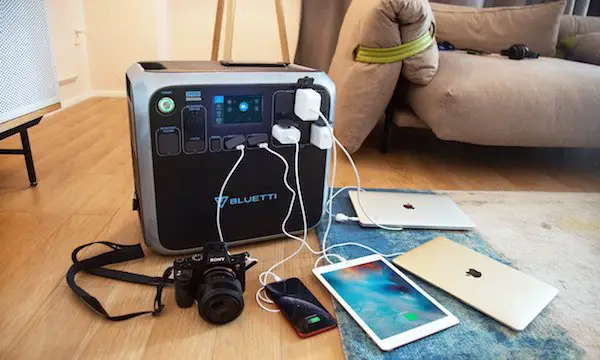Bluetti has amazed us with products such as the AC200, of which the AC200P is an upgrade.
On the other hand, Point Zero Energy has built quite a reputation with the Titan solar generator.
While these two share resemblances in quality and design, they still vary in terms of performance and delivery.
The Titan is better than the Bluetti AC200P in terms of recharging and expandability. With one battery, the Titan will take in 1,000W (solar) and 600W (AC) input. The AC200P will take in 700W (solar) and 400W (AC) input. You can add several batteries to the Titan, whereas with the AC200P you cannot.
Nevertheless, both the Titan and Bluetti AC200P boast several interesting features that are unique to each system, so it can be difficult to decide which system would serve you best.
Related: What Can a Solar Generator Power? (Charging, Capacity, and More)
Titan Solar Generator – Review
The Titan is considered one of the most durable and powerful solar generators on today’s market. Produced by Point Zero Energy, the Titan features superior components, design, and hardware.
What makes it unique are its expandable lithium batteries, AC inverter that can run at 3,000W continuously from its 30A RV port, and recharge times – especially from solar panels.
The Titan can smoothly power refrigerators, TVs, washing machines, phones, tablets, and much more.
Its exterior frame on its power module is constructed of metal, which is very unique compared to the majority of other solar generators, which are made from various plastics.
Since the Titan is such a big solar generator, it needs to charge fast in order to be reliable off the grid. This is supported in the Titan by its input port capabilities.

As seen from the input diagram, there are two solar charging inputs, each with up to 1,000W of solar input. This means that you can use up to 2,000W coming from solar panels to charge the Titan. However, 1,000W of solar input is recommended for one battery attached, while 2,000W is for two or more batteries.
The 1,000W charging limit for one battery attached is recommended because charging the batteries too fast can decrease the cycle life (longevity) of the battery.
This massive amount of solar charging capability comes from the Titan’s two MPPT charge controllers within its power module. Nearly all other solar generators only have one MPPT, if that. The only other solar generator that has a higher solar input capability is the Bluetti EP500Pro, which is capable of up to 2,400W of input.
In addition to solar charging is the Titan’s AC charging power. With one AC charger, you’ll get 600W of charging power. This in itself is one of the fastest single AC chargers for a solar generator.
For example, some of the largest solar generators on the market today are the Bluetti EP500 and the Yeti 6000X. Both of these models also have 600W AC chargers.
However, you can add an additional AC charger to the Titan to get a total of 1,200W of AC input. Adding an additional charger is only recommended for use with two or more batteries. With two batteries (4,000Wh) and two AC chargers, you will be able to fully charge a dead battery in about 3.5 hours.
This is an insanely fast recharge time for a 4,000Wh battery.
The Titan is a large solar generator that takes around 2.5 hours to charge via its maximum solar input of 1,000W (with one battery attached) and 2,000W (with two batteries). This is due to its two MPPT charge controllers within its framework.
Since you can double the solar panel input when you have two or more batteries attached to the system, the solar recharge time is the same with one battery and two batteries attached.
You can also charge it with different charging methods simultaneously. It can be charged from the wall, from the car, and from solar panels.
Let’s check out some of the important features of the Titan solar generator:
- 2x PV (solar) MPPT charge controller inputs, 35-145V/30A per port (up to 2,000W total)
- 2x AC charging inputs (600W each, 1,200W total)
- 1x car cigarette lighter DC input
- 1x battery expansion input (for third-party external batteries)
- Pure sine wave inverter (3,000W continuous, 6,000W surge)
- 4x DC car cigarette lighter outputs (regulated at 13.8V)
- 1x RV 30A outlet
- 6x 120V AC outputs
- 4x USB adapters (8x ports total – 2x with two smart USB-A, and 2x with one smart USB-A and one USB-C)
- Stackable lithium-ion battery packs
- Each battery has 2,000Wh of capacity
- 2-year warranty for power module; 1-year warranty for battery packs
For a well-rounded view of the Titan, I recommend reading my review, where I go more in-depth on its features as well as compare it to two similar power stations: Titan Solar Generator Review – The Best Large Solar Generator?
Bluetti AC200P Solar Generator – Review
The Bluetti AC200P is a high-tech solar generator that incorporates a touchscreen and wireless charging pads into its design. With a big battery, a strong inverter, and a variety of input and output ports, it can meet several charging/powering needs.
The AC200P’s battery is different from that of the AC200, both in its type and capacity. The battery capacity has increased to 2,000Wh from the AC200’s 1,700Wh. In addition, the AC200 has a lithium-ion battery, whereas the AC200P has a LiFePO4 battery.
The LiFePO4 battery has several advantages to the lithium-ion type, but the main advantage is an increased battery cycle life. This allows the AC200P to have a longer overall lifetime than the AC200 model.
LiFePO4 batteries are generally safer than lithium-ion ones as well. This is because they do not overheat or use hazardous materials in their chemical makeup.
Here are some of the key features of the AC200P:
- Pure sine wave inverter (2,000W continuous, 4,800W surge)
- 6x AC outlets
- 2x 15W wireless charging pads
- 1x 60W USB-C PD port
- 4x USB-A ports
- 1x PV (solar) MPPT charge controller input, 35-150V/12A (700W max)
- LiFePO4 battery with 3,500+ charge cycles
- Smart LCD touchscreen/control panel
- 24-month warranty
The AC200P may be the best solar generator within the 2,000Wh battery range.
Its multiple improvements from the previous AC200 will show you that Bluetti took the time to create a system that would be more reliable and powerful than a typical power station.
View the improvements from the AC200 to AC200P in my comparison post here: Bluetti AC200 vs AC200P – Key Differences & Takeaways.
Specs Comparison – Bluetti AC200P vs Titan
The table below compares the Titan and AC200P together to give you some insights into their similarities and differences.
| Model | Titan | AC200P |
|---|---|---|
| Brand | Point Zero Energy | Bluetti |
| Inverter Output | 3,000W continuous, 6,000W surge | 2,000W continuous, 4,800W surge |
| Battery Capacity | 2,000Wh+ | 2,000Wh |
| Weight | 68 lbs (w/ one battery pack) | 60.6 lbs |
| Dimensions | 18.5 x 12 x 12 in | 16.5 x 11 x 15.2 in |
| Ports | 6x AC outlets 2x USB-C* 6x Smart USB-A* 4x DC car outlets 1x 30A RV port | 6x AC outlets 1x DC 12V/25A 1x DC 12V/10A 2x DC 12V/3A 4x USB-A 1x USB-C PD 2x wireless charging ports |
| Cycle Life | 2,000 cycles to 80% capacity | 3,500+ cycles to 80% capacity |
| Cell Type | Lithium-ion | LiFePO4 |
Here are a few of the specific capabilities and features that I am going to go more in-depth on so you can get a good idea of what these systems are like side-by-side:
- Battery Capacity
- Charging Speed
- Weight & Portability
- Expandability
- Battery Cycle Life & Longevity
- Number and Types of Ports
- Display Screen
Battery Capacity
With a usable battery capacity of 2,000Wh and a continuous AC output of 3,000W, the Titan provides remarkable backup power for several off-grid needs.
The most fascinating feature of the Titan is its stackable lithium-ion batteries, which allow you to add as many lithium-ion batteries as you want on top of each other to increase its overall battery capacity.
The Bluetti AC200P also features a battery capacity of 2,000Wh but does not make provision to add extra batteries in order to improve its battery life.
A single Titan battery’s true capacity is 2,200Wh. The reason why its usable capacity is held at 2,000Wh is to extend the life of the battery over time.
For example, if you were to drain a battery completely over and over again before recharging it, its overall lifetime would significantly diminish. Having an extra 200Wh in the Titan’s battery pack when its 2,000Wh of usable power is used up prevents stressing the battery to its limits.
Charging Speed
The following table shows the charging methods and charging speeds with the AC200P and Titan.
| Model | AC200P | Titan |
|---|---|---|
| Brand | Bluetti | Point Zero Energy |
| Solar Input (max) | 3.5-4 hrs (700W) | 2-2.5 hrs (w/ 1x battery – 1,000W) 2-2.5 hrs (w/ 2x batteries – 2,000W) |
| AC Input (w/ one charger) | 6-7 hrs (400W) | 3.5-4 hrs (w/ one battery – 600W) |
| Car Charging | 10 hrs (24V, 200W) 20 hrs (12V, 100W) | 24 hrs (w/ one battery – 85W) |
| Dual AC (Wall) Chargers | 3-3.5 hrs (800W) | 3.5-4 hrs (w/ two batteries – 1,200W)* |
| AC Charging + Solar Input (max w/ one AC charger) | 2.5-3 hrs (1,100W) | 2.5-3 hrs (w/ one battery – 1,000W) 2.5-3 hrs (w/ two batteries – 2,000W) 3-3.5 hrs (w/ three batteries – 2,600W)** |
**AC + solar charging is limited to 1,000W input per battery
The Titan clearly charges faster from AC and solar charging. This is even more impressive as its battery capacity increases. Since the Titan can take in up to 2,000W of solar input with two or more batteries, its recharge time with one battery attached is the exact same as with two batteries attached.
This is because it can only take in 1,000W of solar charge with one battery.
The AC200P can charge fast from solar panels as well as with its 400W AC charger, but it is clearly outshined by the Titan’s capabilities both from solar and wall charging capabilities.
What is outstanding with both systems are their abilities to charge simultaneously from solar and AC inputs as well as with dual AC charging.
Since both of these systems have large batteries, they both are capable of recharging fast, which makes them practical for the user.
The AC200P and the Titan can also charge and discharge power simultaneously. In other words, while you are using the battery to power necessary appliances and electronics, you can also charge the battery at the same time. Since both systems can recharge quickly from solar panels, they will be reliable for several days or longer completely off-grid.
Weight & Portability

Lightweight solar generators are preferable options if you plan to use them for camping purposes and other types of off-grid adventures.
Both the Titan and AC200P are bulky systems and should not be used for these purposes. For the most part, both the Titan and AC200P are considered standby generators, meaning they’re mostly used for backup power at home. This is because they are very heavy. With one battery, the Titan weighs 68 lbs. When you stack on additional batteries, each one brings on an additional 35 lbs to the system’s weight.
At 60.6 lbs, the AC200P is lighter than the Titan by 7.4 lbs. Although this is not a significant weight difference for a large solar generator, it still makes the AC200P easier to move around as one unit.
However, the Titan’s battery easily separates from its power module, splitting its total weight in half. This feature clearly makes the Titan more portable when setting it up and/or moving it around.
There are a few large solar generators that come with either a roll cart or wheels to easily move it around. You can read about these systems below:
- Bluetti EP500 & EP500Pro Review – Longest-Lasting Solar Generators
- The Goal Zero YETI 3000X – In-Depth Review and Comparison
- Yeti 6000X Review – Goal Zero’s Most Powerful Solar Generator
Expandability
The room to improve your solar generator’s capacity by adding more batteries is a very practical feature that most advanced solar generators have.
Having the option for battery expansion allows you to use these systems in your home or cabin for extended periods of time. This can be crucial when power outages happen often in your area. But if you have a cabin that’s completely off-grid, battery expansion is a necessity.
The Titan is popular because of its detachable and expandable batteries, which allows you to add more batteries to increase capacity and performance. You can also add third-party batteries to the Titan, such as LiFePO4 and AGM deep cycle batteries.
The Bluetti AC200P does not have either of these features. You can only use the 2,000Wh battery within it.
The Titan’s high power output and high battery capacity capabilities make it a viable option for powering high-powered appliances and other electronics consistently for days on end.
This is also partially due to its high-speed solar charging, which allows the batteries to recharge quickly during the day to supply ample amounts of power throughout the night.
The Titan’s battery expansion capabilities are very similar to the Inergy Flex 1500’s design.
These two power stations are currently the only ones to have modular designs where you can stack multiple battery packs under the port setup.
If you’d like to compare the two to one another, I created an article putting them up against each other and you can read it here: Titan Solar Generator vs Inergy Flex 1500 – Which Is Best?
Battery Cycle Life & Longevity
How long your batteries can last is determined by cycle life.
Any solar generator’s lifetime depends on its battery capacity, battery type, battery cycle life, and how you use it.
For the Bluetti, you can get 3,500+ charge cycles to 80% battery capacity. This is a huge number compared to several other solar generators similar in size. Bluetti even has a monstrous solar generator called the EP500 that can get 6,000+ charge cycles!
The Titan offers 2,000 charge cycles to 80% capacity. This capability will allow you to use the Titan for about ten years or longer with good maintenance and proper usage.
At a 1,500-cycle decrease from the AC200P, this means that the Titan battery will not last as long as the AC200P’s battery. However, having 2,000 cycles with a lithium-ion battery is still one of the best ratings for higher-end solar generators.
For example, the Yeti 3000X has a lithium-ion battery, but it only has 500 cycles to 80% capacity.
A huge benefit to the Titan’s design is that you can easily get another battery if you need to down the road.
The same cannot be said about the AC200P. Bluetti does not sell replacement batteries, so when your system runs out of battery in several years, you’ll need to replace the entire system. This can be very costly considering that one AC200P costs about $2,000.
Although the Titan is much more expensive than the AC200P upfront ($2,995 for a Titan with one battery), their replacement/expansion batteries cost $1,395. There are two benefits to this. The first is that you do not need to replace your entire system – just the battery – when the battery runs through its rated charge cycles. The second benefit is that it will cost you less to replace the battery as opposed to the entire system.
However, the AC200P has 3,500+ charge cycles, which makes it last 75% longer than the Titan’s battery. This adds to the value of the AC200P because an additional 1,500 cycles can equate to years of additional usage.
As a disclaimer, the cycle life of a battery is based on using it with care. Without proper knowledge of battery maintenance, your battery’s cycle life can decrease substantially. To avoid this, you will need to properly store the battery, charge the battery, and avoid exceeding the power limits of the battery as often as possible.
Additionally, stated in the Titan manual, “[The] maximum life span of [the] battery [is] based on ideal conditions. Actual life span will depend on factors such as charge rate, discharge rate, cycle depth of discharge, and usage and storage conditions.”
Number and Types of Ports
The following table shows all of the output ports available for Titan and AC200P.
| Model | Titan | AC200P |
|---|---|---|
| Brand | Point Zero Energy | Bluetti |
| USB Ports | 2x USB-C 2x USB-A 2x USB-A QC | 4x USB-A 1x USB-C PD |
| AC Ports | 6x AC outlets 1x 30A RV port | 6x AC outlets |
| DC Ports (Besides USB) | 4x DC car outlets | 2x wireless charging ports 1x DC12V/25A 1x DC 12V/10A 2x DC 12V/3A |

Both the AC200P and Titan have six AC ports. The Titan’s AC ports are split into two groups of three ports (surrounded by yellow paint as seen in the image above). Each grouping of three has 15A of current.
With 120V AC sockets, you should be able to get 1,800W of total power output for each grouping of three ports. However, since the inverter’s maximum continuous power output is rated at 3,000W, this number is maxed out at 1,500W for each group of three AC outlets, bringing the total output to 3,000W combined.
To make this more clear, say you have two 1,500W space heaters. You can plug one of them into one of the left-hand side AC port sections and the other heater into the right-hand side section. Both of them should be able to run continuously according to the inverter specifications. You cannot plug both of them into one AC port section, as this will override the maximum output of that section.
With the AC200P, you get 2,800W of continuous power output spread out across its six AC ports.
The Titan has a slightly higher continuous inverter rating than the AC200P, but the 6,000W surge rating of the Titan far exceeds the AC200P’s 4,800W rating. This makes the Titan more adaptive to high power surges that can come from larger appliances.
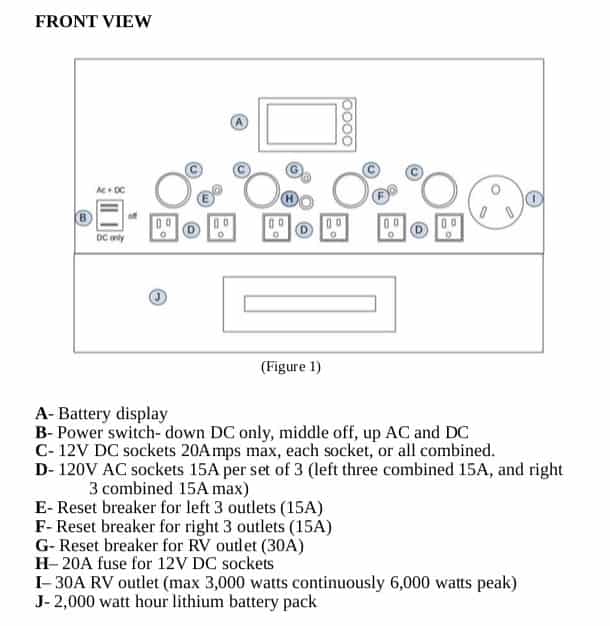
The Titan has four DV cigarette lighter outputs, but they also double as USB chargers. Point Zero Energy gives you four USB adapters to put into each cigarette lighter port to have a total of eight USB outputs. There are two USB-A adapters, each with two USB-A outlets. Then there are two additional adapters, each with one USB-A and one USB-C output.
Although the Titan exceeds the AC200P with four cigarette lighter ports, six USB-A ports, and two USB-C ports, the AC200P has a larger variety of DC outputs that may suit your needs better. The AC200P has a 12V/25A port, 12V/10A cigarette lighter port, two 12V/3A (5.5mm) ports, four USB-A ports, a 60W USB-C PD port, and two wireless charging ports (15W each).
The output port that is most unique with the Titan is its 30A RV port. It is capable of 3,000W continuous and 6,000W surge power. For an RV user, the Titan is clearly the ideal option of the two systems.
Display Screen
The Titan and AC200P have very different display screens. The Titan’s screen gives a lot of important information necessary to run your system properly, however, the AC200P has a touchscreen that includes much more in-depth information.
The touchscreen on the AC200P is one of the first of its kind for the solar generator market. Several companies have LCD screens that help significantly with understanding the system, however, there are many advantages to having a touchscreen, including having detailed information easily accessible.

Both the Titan and AC200P displays show real-time data, including input and output power, battery charge/discharge status, and more.
What separates the AC200P’s display from the Titan (other than its touchscreen) is its ability to allow the user to alter the output voltage, frequency, charging mode, and more.
In addition, the AC200P has something called “Bluetti ECO” mode, which powers down the system when its output is lower than 50W after four hours. This is extremely useful if you forget to turn the system off, as it will discharge anywhere from 6-19W of power when it’s on standby (when nothing is plugged into it).
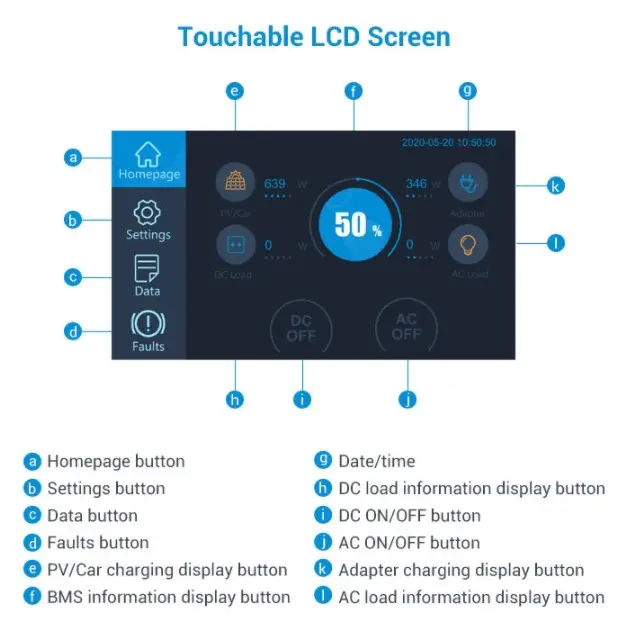
Lastly, one of the most important features of the AC200P’s screen is its ability to display error codes. These codes inform you of any malfunction or warning regarding its internals. There are several error codes that can display while using the system. Whether it’s a temperature warning or a different internal malfunction, it will show you this on its screen.
Although this is not a unique feature of the AC200P (as several solar generators display error messages on their screens), it’s one of the most important ones to have.
Check out this video where the host, Will Prowse, goes over the features of the AC200’s display screen. Note that this is the AC200 model, not the AC200P; however, they both share the same touchscreen.
The Titan does not have error messages on its display screen. This is probably the biggest weakness of the Titan. As a solution to any malfunctions with this system, Point Zero Energy has a “troubleshooting” section in their Titan manual that has solutions to several potential problems that may occur when using the solar generator.
Conclusion
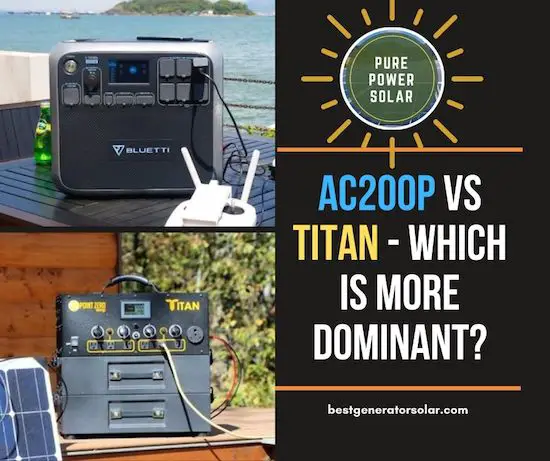
Although the Titan and the AC200P are a close match in terms of power output and battery capacity, the Titan has the advantage when it comes to:
- AC power output
- Battery expansion
- Solar input
- AC input
Having these three advantages means that you can power more appliances/electronics, have as large of a system that you may need, and that you can recharge your system fast enough to use it continuously for several days, months, and years on end – either completely off the grid or for power outages.
I recommend the Titan purely because of its strength. Truly, both models are exceptional, but the Titan is ultimately the better option.
If you’d like more information on the Titan, I have a separate review of the system that goes into more details and compares it to some other similar solar generators as well: Titan Solar Generator Review – The Best Large Solar Generator?
Find the Titan here on shopsolarkits.com and the AC200P here on Amazon. These are affiliate links, where I make a small commission on every sale.
If you’d like more power stations to compare, Bluetti has three systems that are competitive against the Titan. These models are the:
- AC200MAX
- AC300+B300
- EP500Pro
I compare all of these models to EcoFlow solar generators in my post found here: Bluetti vs. EcoFlow – Collective Solar Generator Deep Dive.

